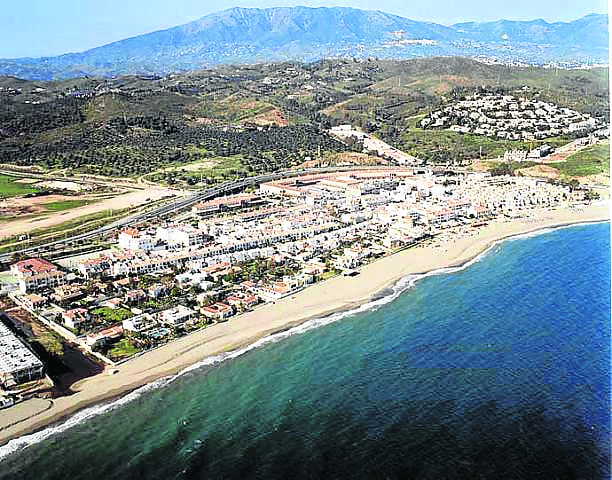THE ocean defines Mijas Costa in the way the mountains shape Mijas Pueblo.

They are two halves of the same municipality, like a well-matched couple with different hobbies.
While the bijou pueblo appeals to country lovers and culture vultures, the racy oceanfront resort is big on social life and sport. It’s not the only municipality with a split personality.
Mijas is Malaga province’s fourth largest municipality and one of the most profitable destinations on the Costa del Sol, thanks to its beach clubs, golf courses and vibrant nightlife.
It spreads over almost 150km² of the province, encompassing a 12km ribbon of coastal communities: Las Lagunas, La Cala de Mijas, Riviera del Sol, Miraflores and Calahonda.
While its sister pueblo is sometimes shrouded in early morning mist, Mijas Costa takes full advantage of the Costa del Sol’s 300 days of sunshine annually and, like its neighbours, it’s rising againfrom the smouldering ashes of the financial crisis.
Its coastline curves around secluded rocky coves fringed with sandy beaches and it spreads inland, too, to a fertile golf valley that’s a fairway to heaven for visitors.
Its six golf clubs offer a huge range of courses to suit all handicaps and budgets.
Sandwiched between glitzy Marbella and funky Fuengirola, like the satisfying filling in a deli sandwich, no wonder famous Brits like TV presenter Chris Tarrant, Olympic rower Sir Steve Redgrave and soccer star Ryan Giggs have been smitten.
Celebrity chef Antony Worrall Thompson owns a property in the area and Irish singer Val Doonican (of diamond-patterned jumper fame) has been coming here for nigh on 30 years.
Between the authentic historical charms of the pueblo and all the sporting and leisure facilities of the coastal scene, Mijas refuses to be pinned down into one single identity.
Its string of seaside villages (see map, far right) showcase an array of great restaurants, bars, hotels and beach hideaways, dazzling like charms on a bracelet.
La Cala de Mijas is one of the jewels, known as the Bay of Mulberries until the 1970s after its signature mulberry trees.
Since the boom of the 1960s, it has been transformed from an Andalucian fishing village to a bustling resort with sophisticated places to dine and dance.
But you’ll still see fishermen hauling in their catch and you can enjoy sardines fresh from the sea from Easter.
There is no doubt that La Cala truly comes alive in summer, as the beach and neighbouring restaurants start to hum with people.
But the big mix of Spanish with English, German, Dutch and Scandinavians is quickly apparent.
“We do not want anyone to feel like a foreigner in Mijas, no matter where they come from,” insists local councillor Mario Bravo.
Historically a place of defence, La Cala’s past is hinted at by the fortified watchtower in the centre of the village.
The tower was originally part of a series along the coast that provided an important system of defence duing the 12th century, warning Fuengirola, Benalmadena and Marbella of the presence of pirates and enemy ships.
Now a museum and tourist information centre, the tower’s exhibitions tell the story of General Torrijos – who led a revolt against King Ferdinand VII’s regime in 1831 – the history of other coastal watchtowers, and the traditional fishing customs of the Mijas Costa.
It was only four decades ago that the village consisted of little more than the watchtower and half a dozen fisherman’s cottages.
Even up to the 1970s, almost all transport was by donkey, recalls Pepe Martin, 58, who has lived in La Cala all his life.
“I was actually born in Malaga and my mother got there just in time with an hour donkey ride to Fuengirola, where she took the train,” he explains.
A gardener at Las Buganvillas urbanisation, he explains how back in the late 1950s most of the land in the area was split between two big families, the first a German family called Berne and the other a wealthy Malaga family called Cotrina.
The two families between them owned most of the land up to Fuengirola and inland towards Mijas village.
“They had most of the land carved up between them and employed many local labourers,” he adds.
His family had a little bit of land of its own, where they grew vines to produce raisins.
“My grandfather used to own a lot of vines but they all died when the phylloxera virus hit. But we grew other things as well and shared farming equipment with other families in the area.
“It was beautiful back then, the land was so unspoilt and the fields were full of life. We had an incredible time growing up here.
“If you had a little bit of land you could live very well, but if you lived in the town of Fuengirola with no land say, you would be pretty poor,” he explains.
Many expat Brits have now settled in the area so language is no longer a barrier, indeed many of the attractions and local businesses are run by foreigners, so you’ll feel quite at home.
With Malaga airport just 25 minutes drive away, Mijas Costa is spruced up for summer and perfectly poised to share in the profits from this year’s predicted tourism bonanza.









What a lovely article and so nice to read about how things used to be before tourism became a big player in Mijas. Great insight by locals who live in La Cala and have welcomed the changes to their village over the years, I love Mijas too which is why I have also made it my home.
Hi,
Reassuring to read your comments, seriously considering retiring to this area….very concerned about meeting new people in my late 50’s, wary of urbanisations that are empty for most of the year. Do you think that the Pueblo or the Costa is best? After working under pressure for years really keen to start a new chapter, but need to move into a community of expats in similar circumstances, thinking possibly of a long term rent given the current uncertainty of the U.K. And the EU. We are heading over in May what areas should we focus on and what ones should we avoid?
I love La Cala! It is tranquil, peaceful and friendly. I often visit the Costa del Sol and always make time to visit La Cala and sit on the lovely beach and blow away the cobwebs. The locals are friendly, they seem to remember me and make me feel very welcome. I enjoy my Menu del Dia at a favourite restaurant and visit the market on Wednesday and Saturdays. I have discovered many a find there and fresh fruit and veg as well. I love the La Cala Lions charity shop, great for a browse and a bargain!
It is a beautiful place to visit and live in, I thoroughly recommend it.
Another example of cultural and coastal destruction…
Having lived in La Cala de Mijas for 7 years, I can assure you all the peaceful town this article depicts is slowly eroding away. The sad influx of “The Only Way is Essex” stereotypes is beginning to take hold of the town through overrated and overpriced bars such as “Olivias” and their claim to be in “Marbs” is a sad reality of the evolution of this once beautiful, quiet and up-market place.
It’s now common to see mass quantities of botox, 10 inch heels and “nouveau riche” falling on the floor smashed out of their heads in the early hours of the morning in the summer. Why the local council allows bars and establishments that encourage this is beyond me, as it brings down the image of the place. My only guess is money….
Then you have the huge amount of development occurring which is both good and bad. Good because it shows growth and prosperity to the area, but it’s badly regulated and you end up with endless bland “modern” box apartments that have no character throughout the area. It’s a mix of contemporary design from the late 90’s and 00’s, and now cheap, fast “modern luxury” boxes of today. Again…money talks.
Having said all that, La Cala de Mijas is still a beautiful place and in the day you have plenty of family-friendly areas to visit and spend the day. You also have spectacular restaurants (not Olivias), and wine bars to enjoy and soak up the evening sun.
There is also La Cala Resort which now enjoys the tranquillity the village once had. It’s not by the beach, but it’s up in the hills and offers beautiful views over Mijas town and the surrounding area.
I for one love La Cala de Mijas and have made it my home, but I really am keeping my fingers crossed it doesn’t become the next “Marbs”, or worse still, Torremolinos.